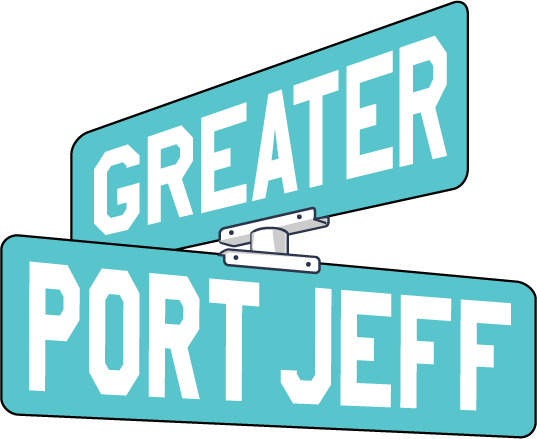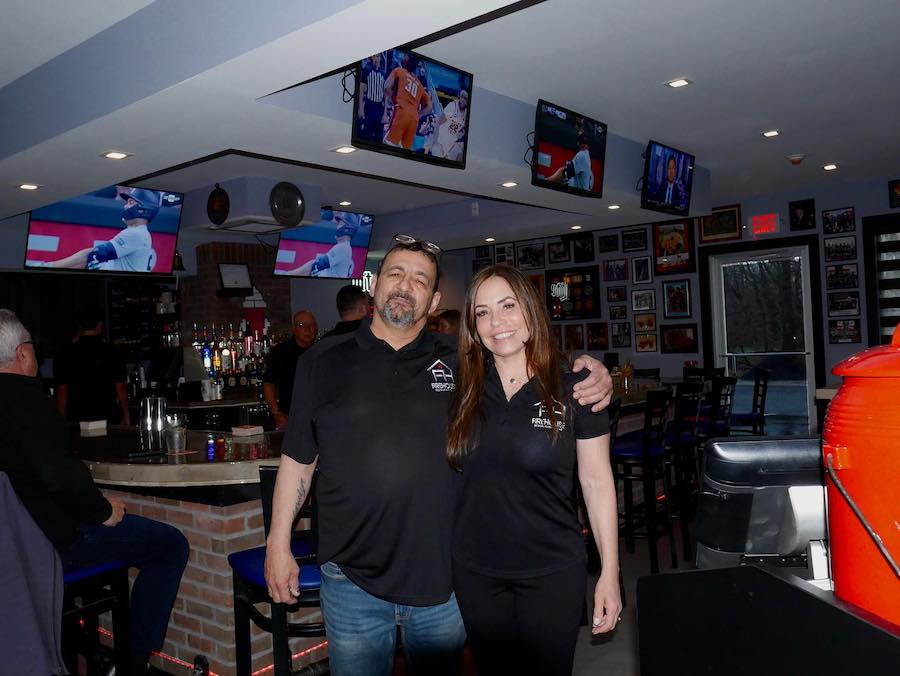
Click here for Greater Long Island newsletters. Click here to download the iPhone app.

When Mount Sinai resident Dennis Dillon, 62, suffered a heart attack on his boat over Labor Day weekend last year, a group of Good Samaritans and quick actions by everyone involved came together to save his life, including an automated external defibrillator (AED) device that another boater happened to have on his vessel.
Dennis had just come back from a swim and when he boosted himself back on board his boat, something felt off and he went to lay down.
“I just got the boat back,” he said in a phone interview with GreaterPortJeff. “I was looking forward to Labor Day and spending the day on the water.”
He was moored in a far corner of Conscience Bay, near Old Field, along with his wife, Tricia, and friends looking to take advantage of the holiday weekend ahead of them. Dillon keeps himself in good shape so he dismissed his pain as a nagging backache from an old snowboarding injury. But then the pain increased and when he laid down in the v-berth of the cabin, his wife suspected it was much worse than just his old injury.
“I saw how much pain he was in,” she said. “I said, ‘I think you’re having a heart attack.’”
Suddenly her husband’s breathing became erratic and he started to get the classic pain in his arm. When he passed out, she started CPR but she knew he needed more help than she could give him at that moment.
“I started screaming, ‘Call 911. I need help.’”
To her, seconds became hours as everything unfolded but one thing is certain: if it wasn’t for a confluence of events, a little luck, preplanning on the part of strangers, and the assistance of fellow boaters that day, her husband would not have survived.
The Dillons were moored up with three other couples, their boats tied together in a row. Friends started scrambling, calling on their radios for help from the Coast Guard, the police, and other boaters in the area.
“My friend shot flare,” she said.
the life-saving efforts
Pieced together from police reports, hospital statements, and various eyewitness accounts from different people involved with the rescue, the chain of events unfolded as follows.
Heather Tearne and her friends, Alan Bertrand, Gary Dayton, and Doug Ewin were also in Conscience Bay that day over from Miamogue Yacht Club in Connecticut when they heard the cries coming from the Dillons’ boat. All four responded immediately.
Tearne, a physical therapy assistant from Stratford, Conn., said they jumped in a dinghy and went toward the calls for help.
“When we got on the boat, Dennis was blue and not breathing,” she said in a phone interview recalling the day. “He was not responsive.”
Tearne and Bertrand began chest compressions.
“He’s a big guy,” she said. “We needed to get him on a solid platform.”
After trying to put a cutting board underneath his body they decided they had to get him onto the floor of the galley.
Josh Stein and his fiancé Dr. Elizabeth Nadal were out on the bay from Connecticut as well from a different club, the Saugatuck Harbor Yacht Club with other boaters. Separately from Tearne’s group, they also responded to the calls from the Dillons’ boat.
“I heard the yells for help,” explained Stein by email. “Got into our dinghy and upon arrival found the gentleman (now known to us as Dennis) unresponsive.”
Dr. Nadal jumped in to perform CPR with Tearne and Bertrand while Stein coordinated with others to call the Coast Guard and 911 to make sure an ambulance would be standing by. They then started hailing for anyone with an AED to respond but the call went unanswered.
“After no replies, I had the idea to switch channels to hail my fellow yacht club members for an AED,” Stein said.
An answer came from a boat owned by their fellow yacht club members Kathleen and Kevin Rooney.
Rooney and his son were able to hand the device to yet another group on the water, Dr. Robert Kloss and his son, Robert Kloss Jr., an EMT, also members of the Saugatuck Harbor Yacht Club.
“They were able to speed over, hop on board, and rotate in with the CPR, and assist with the AED,” Stein explained.
Dr. Nadal, Tearne and Bertrand all continued with chest compressions and CPR along with Kloss Jr. Up to that point, things were not looking good for Dillon. He was unresponsive, had no pulse, and wasn’t breathing on his own.
By all accounts, Tearne was the one running the show in the cabin.
“Honestly, I’m a very quiet person,” she said. “I don’t know what came out of me. It just snapped and came out of me. You do compressions! You breathe!”
Her quick actions were instinctual and surprising to herself.
“It was the first time I ever had to perform CPR.”
(Coincidentally, Tearne and her friends were in the same place almost exactly one year prior when one of the members of her yacht club suffered a stroke and she assisted with that rescue although she did not perform CPR on the patient.)
Time was of the essence for Dillon. Up top, Stein says he made the decision that they had to get Dillon to shore quickly. It took some searching, but they finally located the keys to the Dillons’ boat and Ewing helped get it started.
“I heard, ‘We have to go,’” said Mrs. Dillon. And they unhitched themselves from the other boats and sped toward Port Jefferson Harbor boat ramp to meet the emergency vehicles that they hoped would be waiting for them.
As they raced toward shore, the strangers in the cabin who had come together with continued their work on Dillon, who wasn’t responding to their life-saving efforts. According to Tearne, it was Kloss Jr. who put the AED on Dillon and Dayton said he was reading off instructions as the machine let them know whether what they were doing was effective.
Dayton would shout readings off the AED.
“I was shouting, ‘good compression, bad compression,’” he said.
Then the device alerted them that it was going to shock. Afterward, Tearne looked for Dillon’s pulse.
“I was checking and thought I felt a pulse,” Tearne said. “I wasn’t sure so I asked Alan [Bertrand] to check.”
Bertrand confirmed that the pulse was good but he still wasn’t breathing on his own.
Tearne performed a sternal rub, a technique of firmly rubbing his chest with her palms or knuckles to stimulate a reaction.
“That’s when he gasped for air and started breathing,” she said.
He never regained consciousness but he was breathing on his own and his pulse was strong. They removed the AED device from Dillon.
At the wheel, Stein said he heard the screams of joy come up from the cabin.
Suffolk Police reported that marine bureau officers responded to the 911 call and when they got in close proximity to the boat carrying Dillon, they were signaled that the boat would continue to transport him to shore.
“I saw the ambulance waiting on the ramp, having no dock lines, or anything, someone else took over at the wheel as we approached the ramp so I could jump off and run to get the EMTs and lines to tie the boat to the dock,” Stein explained.
It was Dayton who came up from the cabin to help bring the boat in.
Officers assisted in transferring Dillon from the boat to a Port Jefferson ambulance who then transported him to Stony Brook Univesity Hospital.
the treatment
A statement from Stony Brook Hospital described the treatment Dillon received:
“When Dillon was brought to Stony Brook Hospital’s Coronary Care Unit, his body temperature was lowered to allow time for his brain and body to heal, called a hyperthermia protocol.
“He also had a tiny metal tube coated with a medication called a stent placed into his artery to keep his it clear.”
“I was absolutely a mess,” said Mrs. Dillon but she said that the hospital staff and doctors made her feel at ease.
“From the moment I stepped in there I was completely taken care of and informed from the minute I walked through the doors to hours later when I saw Dennis,” she said. “Not to mention the absolute care they gave him.”
She said that even when family and friends came pouring into the hospital the team made accommodations and respected their privacy.
“They let us take over the cardiac unit lobby,” she said.
Dillon was able to leave the hospital on Sept. 11, 2019, only 11 days after his heart attack.
Now, almost six months later, Dillon will still get choked up recalling the events of that day. He calls Aug. 31, 2019, his second birthday.
“He realizes he is one lucky guy,” said his wife. “He gets emotional when he talks about it.”
Dillon said that he is taking things easier now and is back to work part-time as an orthopedic physician assistant but he’s happy with his recovery so far.
“From the moment I came out of the coma I felt good,” he said. “All through recovery I felt fine.”
He even gets on the treadmill almost every day now.
What Dillon had is sometimes called a “widowmaker.” It’s a heart attack that happens when your left anterior descending (LAD) artery becomes 100 percent occluded, or blocked. The LAD artery supplies blood to a large part of the heart, which is why it’s so deadly.
“I was lucky it didn’t happen in the water,” he said. “It would have been a different story.”
Even still, Dillon beat the odds. Stony Brook Hospital says that only six percent of people who experience cardiac arrest outside of a hospital setting will survive. In addition, a patient’s chances of survival goes down 10 percent for every minute CPR is not initiated.
Dillon says he was in good shape before his heart attack. He ate well, worked out regularly, and led an active lifestyle.
“If it can happen to me, it can happen to any of us,” he said. “I had no symptoms whatsoever.”
raising awareness
He now plans to make it his mission to raise awareness about heart health.
The Dillons said they have a few other positive and practical takeaways from the crisis. One is to make sure the keys to their boat are always in the ignition and ready to go just in case there is another emergency.
Another is the importance of an AED device. He already purchased one for his boat. The Suffolk County Police Department confirmed that all of its marine bureau boats are also equipped with AED devices onboard.
Dillon also said that he has no question in his mind that in addition to the boaters on the water who helped him, the first responders, staff and physicians in the Emergency Room, and physicians and nurses in the Cardiac Catheterization Lab at Stony Brook Hospital are the reason he’s still alive today.
“I find it amazing,” he said of the effort it took.
Months later, the people who helped save his life are still in awe of how everything came together.
“Quick action and so many things fell into place,” said Stein. “It’s quite unbelievable how it all unfolded.”
Tearne — the physical therapy assistant who was one of the first to respond — was astonished when speaking about that August day and how Dillon survived.
“He was gone,” she said. “It’s so amazing.”
On Saturday morning, Feb. 8, the Good Samaritans who helped save Dillon’s life will be honored with Stony Brook University Heart Institute’s Heart Saver Community Award for their efforts. At the event, Dillon, along with his wife and three children, will reunite for the first time with the people who saved his life. February is also American Heart Month.
Top: Courtesy picture of husband and wife, Dennis and Tricia Dillon.























